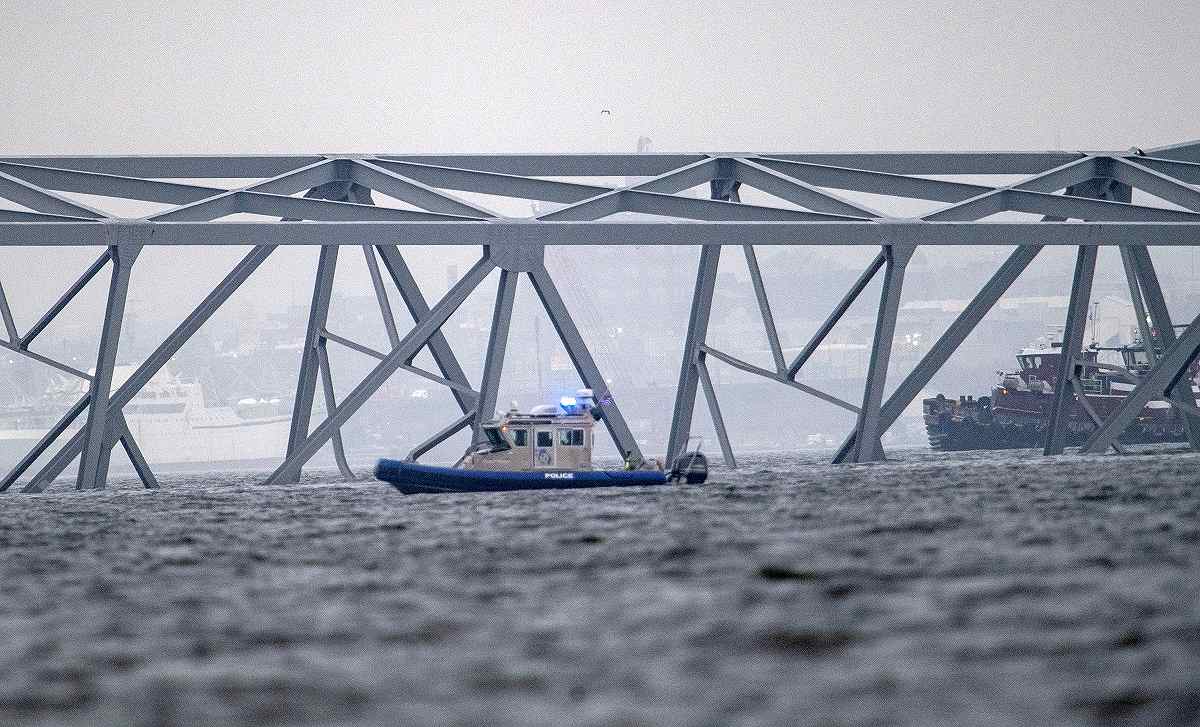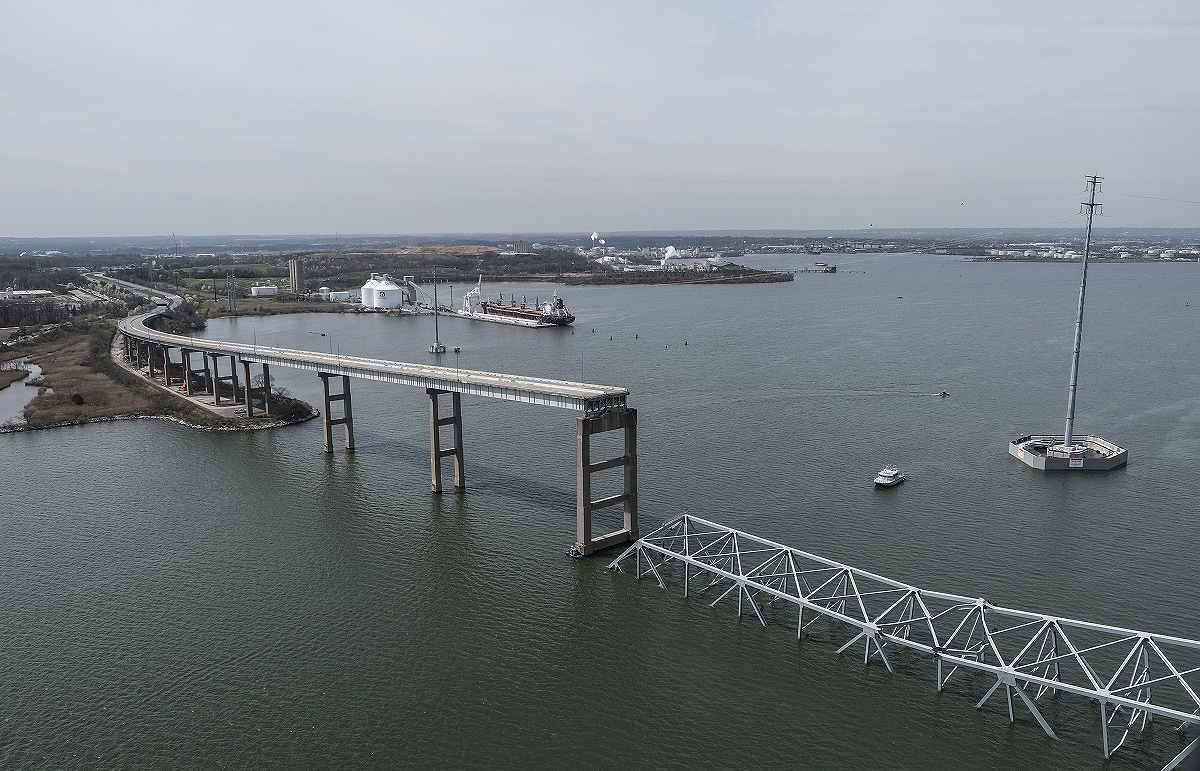
Authorities are turning their focus to salvage operations to remove wreckage from the Patapsco River after the massive container ship Dali caused Baltimore’s Francis Scott Key Bridge to collapse.
16:56 JST, March 29, 2024
Federal transportation officials approved $60 million for Maryland for the first part of Baltimore’s recovery and rebuilding mission for the collapsed Francis Scott Key Bridge.
That money, from the Transportation Department’s emergency relief fund, is a down payment for what will be an expansive project that could take months, if not years, to complete and will require spending legislation in Congress.
By some estimates, Maryland could end up requesting more than $600 million for the Key Bridge from the relief fund and could need over $1 billion to erect a new bridge, according to two people familiar with early government estimates. The people spoke on the condition of anonymity to share details from private conversations. The Transportation Department’s relief fund only has about $1 billion in it now, which could press Congress into urgent action to replenish it before the end of the year, the people said.
That price tag does not include the cumbersome task of reopening the Patapsco River waterway that leads to the Port of Baltimore. The Army Corps of Engineers and other federal agencies will assume that cost, Sen. Chris Van Hollen (D-Md.) told The Washington Post on Thursday.
“We expect that Congress will come to our help,” Sen. Ben Cardin (D-Md.) told The Post. “When you have a catastrophic event affecting infrastructure of this type, the federal government needs to be there, has been there in the past, and we expect it will be there for Baltimore for the replacement bridge.”
Maryland transportation officials asked for federal emergency relief funds Wednesday, and Gov. Wes Moore (D) had earlier declared a state of emergency, making the state eligible for quick access to hundreds of millions of dollars in aid.
Federal agencies, including the Army Corps of Engineers, will assume the full cost of clearing shipping lanes in the Patapsco River to reopen the vital Port of Baltimore, Van Hollen told The Post.
“That’s obviously a very, very big commitment, and they will cover all of those costs,” Van Hollen said.

The remnants of Baltimore’s Francis Scott Key Bridge on Tuesday. The recovery’s cost and the state’s potential share of it are unclear.
But Maryland taxpayers could still be left to foot some of the costs, based on the structure of the Transportation Department’s emergency relief fund. Maryland’s congressional delegation is planning to introduce legislation for more federal dollars to cover any gap, but it would have to pass both chambers of Congress. It’s not yet clear how much the total cost might be, or how much the relief fund might leave for the state to pay.
President Biden said earlier in the week that the federal government should pay for the full amount to restore the waterway and erect a new bridge.
“When it comes to using those funds for the design and ultimately the construction of new bridge, there’s a cost share where the federal government picks up the lion’s share of the costs, but not all of it,” Van Hollen said. “And that’s where Senator Cardin and I plan to introduce legislation to ensure that the federal government is able to pick up the full costs going forward.”
Cardin told The Post that he’d received messages of support from Republican colleagues in Congress, which made him hopeful that legislation to support Baltimore would not face political roadblocks.
Money from the federal Transportation Department’s emergency relief fund will cover Maryland’s costs to divert traffic away from the collapsed portion of Interstate 695, the major thruway that used the Key Bridge, and for the design and rebuild of a new structure, Van Hollen said.
Under the relief program, the federal government pays for 90 percent of repairs, while the state is responsible for the remaining 10 percent. But federal agencies will reimburse 100 percent of repair work conducted in the first 270 days after a disaster to restore essential travel ways, minimize damage and protect remaining facilities.
Such a large outlay for the bridge crisis may hurt the long-term viability of the emergency relief fund, Van Hollen added. Biden’s 2021 Infrastructure Investment and Jobs Act provided $100 million a year to the program.
“The emergency relief fund will need to be plussed up, not just for this Baltimore bridge replacement, but for other projects that it supports,” Van Hollen said. “That will be something that we will be working closely with the White House to accomplish.”
Policymakers have already begun discussing raising the height of a new bridge, he said, and incorporating new technology to make the structure safer. The 47-year-old Key Bridge was constructed without any “redundancy” that would keep it from toppling if a major support was struck, National Transportation Safety Board Chair Jennifer Homendy said.
Van Hollen said he has communicated with Sen. Tom Carper (D-Del.), whose Environment and Public Works Committee has jurisdiction over federal highways, and congressional appropriators about a funding bill. He and Cardin have sought a call with House Speaker Mike Johnson (R-La.) but have not yet spoken with him, Van Hollen said.
Congressional spending for Maryland, though, could take months to pass, even if things flow smoothly on Capitol Hill.
Lawmakers will need a request from the Biden administration and Maryland officials with a firm dollar figure to begin crafting an emergency spending, or appropriations, package. Congress just passed full-year funding for the federal government before the bridge disaster, so new money would need a separate spending bill.
It’s not yet clear how long federal and state officials will need to draw up plans for a new bridge. And lawmakers are in the midst of a two-week recess in their home districts. They are set to return to Washington to take up other pressing spending priorities – including U.S. support for Ukraine and Israel – the second week of April.
A Maryland aid bill could get a boost due to changes on the House’s powerful Appropriations Committee. Rep. Tom Cole (R-Okla.), head of the panel’s transportation subcommittee, is the front-runner to take over as the full committee’s chair. Cole is well-liked among Democrats for his bipartisan streak and institutional knowledge.
Maryland also has robust representation on the panel; half of the state’s House delegation sits on the committee.
Rep. Andy Harris (R) chairs another subcommittee, and Rep. Steny H. Hoyer (D) is one of the longest-serving members on the panel, commanding significant influence on federal spending. Rep. C.A. Dutch Ruppersberger (D), whose district surrounds the city of Baltimore, and Rep. David Trone (D), whose district covers Western Maryland and reaches Baltimore’s outermost suburbs, also sit on the Appropriations Committee.
"News Services" POPULAR ARTICLE
-

American Playwright Jeremy O. Harris Arrested in Japan on Alleged Drug Smuggling
-

Japan’s Nikkei Stock Average as JGB Yields, Yen Rise on Rate-Hike Bets
-

Japan’s Nikkei Stock Average Licks Wounds after Selloff Sparked by BOJ Hike Bets (UPDATE 1)
-

Japan’s Nikkei Stock Average Buoyed by Stable Yen; SoftBank’s Slide Caps Gains (UPDATE 1)
-

Japanese Bond Yields Zoom, Stocks Slide as Rate Hike Looms
JN ACCESS RANKING
-

Keidanren Chairman Yoshinobu Tsutsui Visits Kashiwazaki-Kariwa Nuclear Power Plant; Inspects New Emergency Safety System
-

Imports of Rare Earths from China Facing Delays, May Be Caused by Deterioration of Japan-China Relations
-

University of Tokyo Professor Discusses Japanese Economic Security in Interview Ahead of Forum
-

Japan Pulls out of Vietnam Nuclear Project, Complicating Hanoi’s Power Plans
-

Govt Aims to Expand NISA Program Lineup, Abolish Age Restriction



















